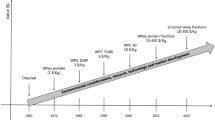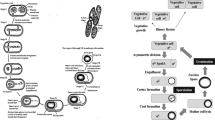Abstract
The zeta potential of a molecule is an important property in the food industry, since the electrostatic potential of a material governs its ability to interact through ionic forces with other molecules in solution. In particular, emulsions that are kept in solutions with a high magnitude of the zeta potential are shown to be more stable over time, as the electrostatic repulsive forces of protein far from its isoelectric point can help prevent oil globule coalescence over time. However, modeling the zeta potential of protein is difficult given the anisotropy of protein molecules, the shifts in amino acid side chain ionization across pH, and understanding at what distance to measure the zeta potential from the molecular surface to accurately capture the shear plane between the particle and solvent under flow. In this work, we use the Poisson-Boltzmann Equation to model the net electrostatic surface potential of pea vicilin and legumin. We then use a weighted average of these globular proteins to predict the measured zeta potential in pea protein. The R2 between the bioinformatically modeled net surface charge and the measured commercial isolate zeta potential is 0.987 between pH 2.50 and 9.50, and this equation predicted the zeta potential of a different commercial pea protein isolate with a standard error of 0.040. This shows that using the Poisson-Boltzmann Equation to solve for the net electrostatic surface potential, it is possible to accurately estimate the zeta potential of pea protein.






Similar content being viewed by others
Data Availability Statement
We affirm that we archive shared data in a manner which it can be reasonably accessed. All models shown have appropriate accession numbers for others to find, and any manipulations are stored in our lab network.
References
B. Oliveria, A. de Moura, L. Cunha, Increasing Pulse Consumption to Improve Human Health and Food Security and to Mitigate Climate Change (Springer, In Climate Change-Resilient Agriculture and Agroforestry, 2019)
P. Kumar, Chatil, N. Metha, P. Singh, Malav, A. Verma, Meat analogues: health promising sustainable meat substitutes. Crit. Rev. Food Sci. Nutr. 57(5), 923–932 (2015)
T. Geistlinger. Plant based meat structured protein products. US 2015/0296834 A1, October 22, 2015
Klassen, Nickerson, Effect of PH on the formation of electrostatic complexes within admixtures of partially purified pea proteins (Legumin and Vicilin) and gum arabic polysaccharides. Food Res. Int. 46(1), 167–176 (2011)
T. Burger, Y. Zhang, Recent progress in the utilization of pea protein as an emulsifier for food applications. Trends Food Sci. Technol. 86, 25–33 (2018)
M. Chen, L. Juhui, F. Liu, J. Nsor-Atindana, F. Xu, H.D. Goff, J. Ma, F. Zhong, Study on the emulsifying stability and interfacial adsorption of pea proteins. Food Hydrocolloids 88, 247–255 (2019)
H. Helmick, H. Turasan, M. Yildirim, A. Bhunia, A. Liceaga, J. Kokini, Cold denaturation of proteins: where bioinformatics meets thermodynamics to offer a mechanistic understanding: pea protein as a case study. J. Agric. Food Chem. (2021). https://doi.org/10.1021/acs.jafc.0c06558
C.-H. Tang, Emulsifying properties of soy proteins: a critical review with emphasis on the role of conformational flexibility. Crit. Rev. Food Sci. Nutr. 57(12), 2636–2679 (2017). https://doi.org/10.1080/10408398.2015.1067594
C.M. Beliciu, C.I. Moraru, The effect of protein concentration and heat treatment temperature on micellar casein-soy protein mixtures. Food Hydrocolloids 25(6), 1448–1460 (2011). https://doi.org/10.1016/j.foodhyd.2011.01.011
T.J. Dolinsky, J.E. Nielsen, J.A. McCammon, N.A. Baker, PDB2PQR: an automated pipeline for the setup of poisson-boltzmann electrostatics calculations. Nucleic Acids Res. 32(suppl_2), W665–W667 (2004). https://doi.org/10.1093/nar/gkh381
A. Malhotra, J.N. Coupland, The effect of surfactants on the solubility, zeta potential, and viscosity of soy protein isolates. Food Hydrocolloids 18(1), 101–108 (2004). https://doi.org/10.1016/S0268-005X(03)00047-X
E. Pettersen, T. Goddard, C. Huang, G. Couch, D. Greenblatt, E. Meng, T Ferrin. UCSF Chimera—a visualization system for exploratory research and analysis. J. Comput. Chem. 25(13) (2004)
L. Bordoli, T. Schwede. Automated Protein Structure Modeling with SWISS-MODEL Workspace and the Protein Model Portal. In Homology Modeling (Humana Press, 2011), vol. 857, pp 107–136.
T. Withana-Gamage, D. Hegedus, X. Qiu, W. Janitha, In Silico Homology Modeling to predict functional properties of cruciferin. J. Agric. Food Chem. 59(24), 12925–12938 (2011)
E. Jurrus, D. Engel, K. Star, K. Monson, J. Brandi, L.E. Felberg, D.H. Brookes, L. Wilson, J. Chen, K. Liles, M. Chun, P. Li, D.W. Gohara, T. Dolinsky, R. Konecny, D.R. Koes, J.E. Nielsen, T. Head-Gordon, W. Geng, R. Krasny, G.-W. Wei, M.J. Holst, J.A. McCammon, N.A. Baker, Improvements to the APBS biomolecular solvation software suite. Protein Sci. 27(1), 112–128 (2018). https://doi.org/10.1002/pro.3280
N.A. Baker, D. Sept, S. Joseph, M.J. Holst, J.A. McCammon, Electrostatics of nanosystems: application to microtubules and the ribosome. Proc. Natl. Acad. Sci. 98(18), 10037–10041 (2001). https://doi.org/10.1073/pnas.181342398
A. Chakravorty, Z. Jia, L. Li, E. Alexov, A new DelPhi feature for modeling electrostatic potential around proteins: role of bound ions and implications for zeta-potential. Langmuir 33(9), 2283–2295 (2017). https://doi.org/10.1021/acs.langmuir.6b04430
J. Riley. Charge in colloidal systems. In Colloid Science (Wiley, Ltd, 2005), pp 14–35. https://doi.org/10.1002/9781444305395.ch2
L. Li, C. Li, Z. Zhang, E. Alexov, On the dielectric “Constant” of proteins: smooth dielectric function for macromolecular modeling and its implementation in DelPhi. J. Chem. Theory Comput. 9(4), 2126–2136 (2013). https://doi.org/10.1021/ct400065j
W.N. Ainis, A. Boire, V. Solé-Jamault, A. Nicolas, S. Bouhallab, R. Ipsen, Contrasting assemblies of oppositely charged proteins. Langmuir 35(30), 9923–9933 (2019). https://doi.org/10.1021/acs.langmuir.9b01046
Chimera. Command: surface https://www.rbvi.ucsf.edu/chimerax/docs/user/commands/surface.html. Accessed 1/5/2021.
C.R. Harris, K.J. Millman, S.J. van der Walt, R. Gommers, P. Virtanen, D. Cournapeau, E. Wieser, J. Taylor, S. Berg, N.J. Smith, R. Kern, M. Picus, S. Hoyer, M.H. van Kerkwijk, M. Brett, A. Haldane, J. Fernández del Río, M. Wiebe, P. Peterson, P. Gérard-Marchant, K. Sheppard, T. Reddy, W. Weckesser, H. Abbasi, C. Gohlke, T. Oliphant, E. Array Programming with NumPy. Nature 585, 357–362 (2020). https://doi.org/10.1038/s41586-020-2649-2
W. McKinney, others. Data structures for statistical computing in python. In Proceedings of the 9th Python in Science Conference (Austin, TX, 2010), vol. 445, pp 51–56
J.D. Hunter, Matplotlib: A 2D graphics environment. Comput. Sci. Eng. 9(3), 90–95 (2007). https://doi.org/10.1109/MCSE.2007.55
M.L. Waskom, Seaborn: statistical data visualization. J Open Source Softw. 6(60), 3021 (2021). https://doi.org/10.21105/joss.03021
H.-N. Liang, C.-H. Tang, PH-dependent emulsifying properties of pea [Pisum Sativum (L.)] proteins. Food Hydrocolloids 33(2), 309–319 (2012)
K. Shevkani, N. Singh, A. Kaur, J. Rana, Structural and functional characterization of kidney bean and field pea protein isolates: a comparative study. Food Hydrocolloids 43, 679–689 (2013)
Y. Wei, Z. Cai, M. Wu, Y. Guo, R. Tao, R. Li, P. Wang, A. Ma, H. Zhang, Comparative studies on the stabilization of pea protein dispersions by using various polysaccharides. Food Hydrocolloids 98, 105233 (2020). https://doi.org/10.1016/j.foodhyd.2019.105233
A.H. Boschitsch, M.O. Fenley, A fast and robust poisson-boltzmann solver based on adaptive cartesian grids. J. Chem. Theory Comput. 7(5), 1524–1540 (2011). https://doi.org/10.1021/ct1006983
W. Geng, R. Krasny, A treecode-accelerated boundary integral poisson-boltzmann solver for electrostatics of solvated biomolecules. J. Comput. Phys. 247, 62–78 (2013). https://doi.org/10.1016/j.jcp.2013.03.056
K.W. Kaufmann, G.H. Lemmon, S.L. DeLuca, J.H. Sheehan, J. Meiler, Practically useful: what the Rosetta Protein Modeling Suite can do for you. Biochemistry 49(14), 2987–2998 (2010). https://doi.org/10.1021/bi902153g
Acknowledgements
We thank the William R. Scholle Endowment to the Kokini laboratory to support research expenditures. We also thank Glanbia Nutrition for their donation of pea protein which was used as the comparison in zeta potential testing. This work is part of the USDA-NIFA grant 1024316.
Funding
We thank the William R. Scholle Endowment to the Kokini laboratory to support research expenditures. We also thank Glanbia Nutrition for their donation of pea protein. This work is part of the USDA-NIFA grant 1024316.
Author information
Authors and Affiliations
Corresponding author
Ethics declarations
Ethics Approval
We affirm that all work here has been conducted in an ethical manner and that it is original work for publication that has not been shared elsewhere. The patient consent and permission to reproduce do not apply to this work.
Conflict of Interest Disclosure
We affirm that none of the author in this work have any conflicting interests for its publication.
Additional information
Publisher's Note
Springer Nature remains neutral with regard to jurisdictional claims in published maps and institutional affiliations.
Practical Applications
This work can be used to generate molecular models of protein for analyzing their zeta potential. The models for pea protein have been made in this paper, but the approach is generalizable to any protein for which a homology model can be generated. As such, this could be applied to model the zeta potential for many different proteins, using only the amino acid sequence information. This may help understand functionalities including gelation, complex coacervation, and emulsion stability.
Rights and permissions
About this article
Cite this article
Helmick, H., Hartanto, C., Bhunia, A. et al. Validation of Bioinformatic Modeling for the Zeta Potential of Vicilin, Legumin, and Commercial Pea Protein Isolate. Food Biophysics 16, 474–483 (2021). https://doi.org/10.1007/s11483-021-09686-8
Received:
Accepted:
Published:
Issue Date:
DOI: https://doi.org/10.1007/s11483-021-09686-8




